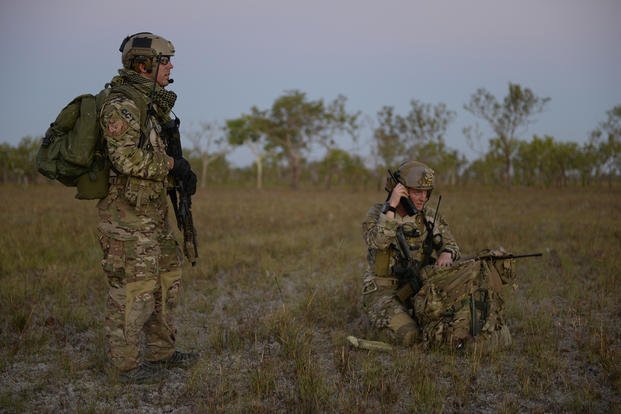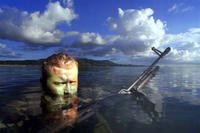The 353rd Special Operations Group is the focal point for all U.S. Air Force special operations activities throughout the U.S. Pacific Command theater. The group is comprised of more than 750 airmen and home-based at Kadena Air Base, Japan. It is the only Air Force Special Operations unit in the Pacific.
The 353rd SOG is prepared to conduct a variety of high-priority, low-visibility missions. Its mission is air support of joint and allied special operations forces in the Pacific. It maintains a worldwide mobility commitment, participates in Pacific theater exercises as directed and supports humanitarian and relief operations.
History
The 353rd Special Operations Group traces its origins to the 3rd Air Commando Group, which activated on May 1, 1944. The 3rd ACG was one of three Air Force special operations units created during World War II to operate independently deep behind enemy lines. The group flew a mixture of aircraft to accomplish their mission: P-51 Mustangs, C-47 Dakotas and L-5 Sentinels.
The 3rd ACG moved to the Philippines in December 1944. The group's fighter squadrons, the 3rd and 4th Fighter Squadron (Commando), made raids on Japanese airfields and installations and performed close air support missions for ground forces on Luzon. The group's 318th Troop Carrier Squadron (Commando) was the lifeline of the 3rd ACG, transporting personnel and supplies to the group and guerrilla forces throughout the Southwest Pacific. The group's 157th, 159th and 160th Liaison Squadrons (Commando) evacuated casualties from frontlines and adjusted artillery fire for ground forces.
The group moved to the Ryukyu Islands in August 1945 and flew supplies from the Philippines to Okinawa. On March 25, 1946, the 3rd ACG was inactivated at Chitose, Japan. The group was disestablished Oct. 8, 1948.
During the Vietnam War, the predecessor to the 353rd Special Operations Group was the 553d Reconnaissance Wing. The 553rd RW organized on Feb. 25, 1967, at what was then Otis Air Force Base, Massachusetts. (It is now Otis Air National Guard Base.) The wing began combat operations from Korat Royal Thai Air Force Base on Nov. 25, 1967. The unit's unique mission was to monitor and relay information along the Ho Chi Minh Trail. The operation, known later as IGLOO WHITE, utilized seismic sensors to detect enemy ground forces.
Batcat crews continuously monitored the Ho Chi Minh Trail 24 hours a day, utilizing highly modified Lockheed EC-121R Super Constellation aircraft. A detachment from the 553rd RW at Nakhon Phanom, Thailand, provided combat assessments of the Beechcraft YQU-22A. The detachment evaluated and flew combat missions in the Beech QU-22B Pave Eagle II. On Oct. 1, 1970, the Pave Eagle IIs became fully operational, reducing the need for EC-121R operations. The 553rd RW was inactivated Dec. 15, 1970.
On July 31, 1985, the 3rd ACG was reestablished and consolidated with the 553rd RW. The same day, the 553rd RW was redesignated the 353rd Reconnaissance Wing.
It wasn't until April 6, 1989, that the Air Force redesignated the 353rd and activated the 353rd Special Operations Wing at Clark Air Base in the Philippines. The activation was a major milestone in the Air Force's effort to enhance and upgrade its special operations forces' capability. The activation brought two U.S. Pacific Command-assigned SOF units, the 1st and 31st Special Operations Squadrons, under one parent organization. Later that year, the wing gained a third flying squadron with the activation of the 17th Special Operations Squadron at Kadena Air Base.
On June 12, 1991, Mount Pinatubo erupted, sending a cloud of ash 80,000 feet into the air. All aircraft assigned to the 353rd SOW at Clark AB were evacuated in less than three hours. Reclamation and recovery of personnel and government property became an equal priority with operational duties. In July 1991, the wing began recovering and repositioning more than $30 million worth of property and equipment to Kadena Air Base.
In 1992, the Air Force radically reorganized in order to draw down the size of headquarter staffs. During the process, the 353rd SOW was redesignated the 353rd Special Operations Group, effective Dec. 1, 1992, in accordance with special order GA-015. The 353rd Special Operations Group was composed of the 1st, 17th and 31st Special Operations Squadrons. The 1st Special Operations Squadron flew MC-130E Combat Talon I and MC-130H Combat Talon II aircraft, the 17th Special Operations Squadron operated HC-130P/N Combat Shadows, and the 31st Special Operations Squadron flew Sikorsky MH-53J Pave Low III helicopters. The 31st Special Operations Squadron was separated geographically from the group, operating out of Osan AB, South Korea. Support squadrons included the 353rd Maintenance Squadron and the 353rd Operations Support Squadron.
On Jan. 1, 1993, the 320th Special Tactics Squadron was assigned officially to the 353rd SOG. The 320th STS personnel added unique and extremely vital capabilities to support the group's mission. The squadron's highly trained combat controllers established drop zones, landing zones and established assault zones with air traffic control capability in non-permissive environments. Combat control teams, or CCT, also established recovery zones (for surface-to-air recovery of personnel and equipment) and provided ground-based fire control for AC-130 gunship operations. In addition, CCTs provided vital command and controls, surveying capabilities, limited weather observations and were qualified in demolitions to clear obstructions and hazards. The pararescuemen assigned to the squadron administered emergency medical care, evacuated injured personnel and were trained to act as aircrew gunners from fixed and rotary wing aircraft.
Squadrons assigned to the 353rd Special Operations Group were utilized to augment forces for multiple operations throughout the 1990s. In July 1995, the 17th SOS deployed one Combat Shadow crew to Dhahran, Saudi Arabia, in support of Operation Southern Watch. The 17th SOS deployed a Combat Shadow crew to San Vito, Italy, in support of Operation Joint Guard/Endeavor in December 1996. The event marked the first time a crew from the 17th had logged combat time since the Vietnam War.
The new millennium brought with it the end of vertical lift special operations capabilities within the 353rd Special Operations Group. On June 15, 2001, the 31st SOS inactivated at Osan Air Base, South Korea. During their tenure with the 353rd Special Operations Group, the Black Knights of the 31st performed countless rescue and humanitarian missions. Their mission was retasked to the U.S. Army.
Humanitarian Aid
The 353rd has responded to countless emergencies throughout Asia and abroad. In 1990, the 353rd came to the aid of its host country, the Philippines, after a 7.7 earthquake hit the island of Luzon. The epicenter of the quake occurred in the town of Cabanatuan, causing severe damage and mass casualties. The relief effort lasted more than three weeks in which the 353rd evacuated more than 1,000 patients and delivered 110,000-plus pounds of supplies to the region. All three flying squadrons participated in the operation, performing medical evacuations, supply movements and establishing forward area refueling points.
Members from the group deployed four aircraft to Bangkok airport, Thailand, in the wake of killer tsunamis that devastated the region on Dec. 26, 2004. The group's role as first responders aided the larger relief effort, Operation Unified Assistance. Combat controllers from the 320th STS rapidly surveyed airfields to allow more humanitarian aid to be received and eased congestion. The 17th SOS and 1st SOS flew nearly one million pounds of cargo. The flying squadron's ability to land on short, unprepared strips helped distribute more than 600 aid workers into some of the hardest-to-reach areas.
On Sept. 26, 2008, members from the 320th STS, 1st SOS and the 18th Wing's 31st Rescue Squadron conducted a complex rescue operation at night to save two mariners who were injured in a crane accident aboard a container ship, the Occam's Razor. A joint team of pararescuemen and combat controllers were flown to the vessel situated 750 nautical miles from Guam onboard a MC-130H Combat Talon II from the 1st SOS. Both men were evacuated to a hospital on Guam.
In 2009, members of the 353rd SOG became the first foreign military aircraft to deliver humanitarian aid to western Indonesia after a 7.6 earthquake and 6.8 aftershock struck Sept. 30 and Oct. 1. A MC-130P Combat Shadow from the 17th SOS delivered more than six tons of relief supplies and 25 international relief workers. More than 65 members from several of the SOG's specialties supported a wide variety of relief efforts. Communications personnel established communications capabilities at four locations. Pararescue and medical personnel joined a five-person Indonesian rescue team and treated patients at multiple locations while aiding the team's search and recovery efforts. MC-130P Combat Shadow aircrews flew 38 flights that transported approximately 130 people and more than 216,000 pounds of cargo, food, medical supplies and miscellaneous equipment. Combat controllers assigned to the 353rd SOG assisted Indonesian military forces in surveying and opening Tabing Airport (now Sutan Sjahrir Air Force Base), which was responsible directly for the movement of more than 140,000 pounds of relief supplies and more than 500 personnel supporting relief efforts.
Airmen from the 353rd SOG worked closely with Japanese officials to open and manage airfield operations at Sendai Airport from March 16 through April 5, 2011. During their operations at Sendai Airport, airmen from the group provided air traffic control services for more than 250 relief aircraft from multiple nations; received 167 humanitarian cargo missions; processed 517 aid workers; received and offloaded more than 2.5 million pounds of humanitarian relief supplies and more than 109,000 pounds of fuel. Airmen from the 353rd SOG opened Matsushima Air Field, Sendai Airport and provided fuel to establish a forward area refueling point at Yamagata Airport. They also conducted surveys of Tohoku University Hospital and Hanamaki Airport. Pararescuemen from the group's 320th Special Tactics Squadron flew countless search-and-rescue missions and aircrews from the 1st and 17th Special Operations Squadrons flew 161 relief sorties, delivered 878,000 pounds of relief supplies, transported 534 relief personnel and offloaded 185,000 pounds of fuel during Operation Tomodachi.
Global War on Terrorism
The 353rd's experience with fighting terrorism can be traced to the first month of the organization's existence. On April 21, 1989, the 31st SOS was tasked to recover the body of Army Col. Nick Rowe after he was shot and killed by terrorists in the Philippines.
In June 2002, the 353rd SOG participated in the repatriation of Martin and Gracia Burnham, missionaries who were held hostage for more than a year in the Philippines by terrorists from the Abu Sayyaf Group. During a rescue attempt by Philippine forces, Martin Burnham was killed, and his wife was wounded. Members of the 353rd flew Gracia Burnham to a hospital in Manila for treatment and flew the body of Martin Burnham to Kadena AB.
During March 2003, a crew from the 1st SOS participated in a six-ship package of MC-130H Combat Talon IIs into Northern Iraq. The crews flew Army Special Forces troops more than 700 miles at an altitude of 250 feet to a landing zone in Bashur, Iraq. The MC-130Hs received intense anti-aircraft fire during the mission.
On Feb. 28, 2006, 320th STS member Master Sgt. David Beals' team was caught in a well-planned ambush during a convoy operation in Afghanistan. The ambush, initiated with an improvised explosive device (IED), trapped the entire team within the enemy's kill zone. Beals immediately repositioned his HMMWV for offensive action and began firing the HMMWV's M240 machine gun on the enemy. During the firefight, he switched to his M203 grenade launcher and repelled the enemy with 40mm grenades. His actions saved the lives of his entire team. Beals earned the Bronze Star with Valor for his courage and heroism.
Today, the 353rd SOG fills the need for special operations forces in the nation's largest theater while simultaneously supporting the Republic of Philippines security forces in their fight against terrorism. It also conducts combat operations in Iraq and Afghanistan, supporting the Global War on Terrorism. The 1st and 17th Special Operations Squadrons consistently deploy aircrews to serve in Afghanistan and Iraq. The 320th Special Tactics Squadron deployed pararescuemen, combat weathermen and combat controllers into all three theaters continuously since 2003.
Want to Learn More About Military Life?
Whether you're thinking of joining the military, looking for fitness and basic training tips, or keeping up with military life and benefits, Military.com has you covered. Subscribe to Military.com to have military news, updates and resources delivered directly to your inbox.











